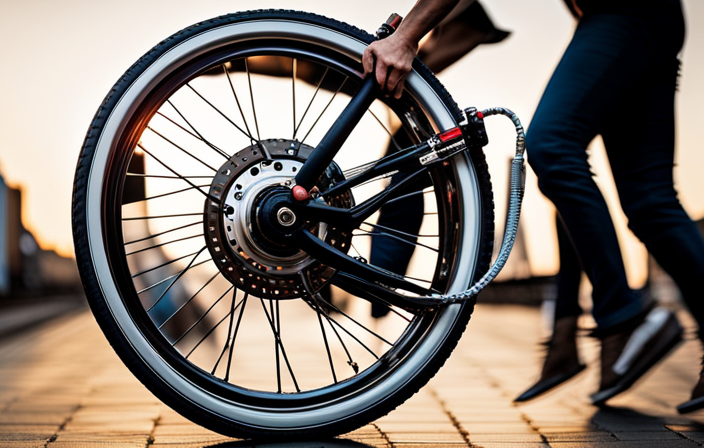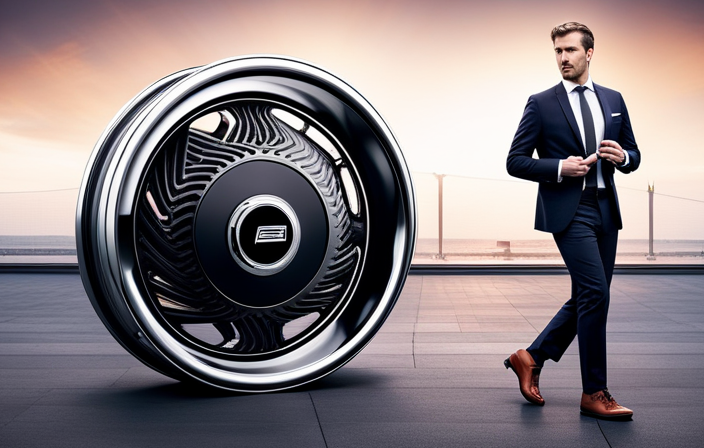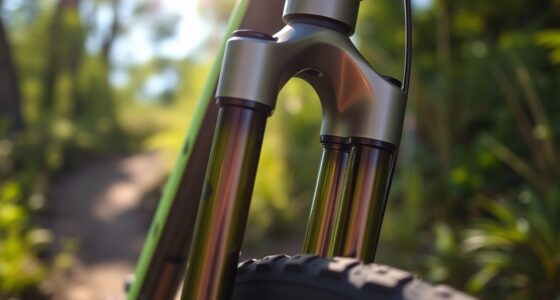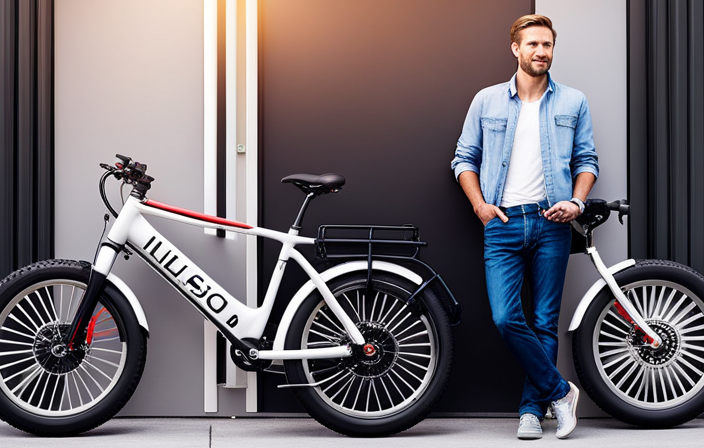Imagine effortlessly cruising down the road on your bike, powered by an electric wheel that you built yourself.
In this detailed guide, I will walk you through the process of building a bike electric wheel, step by step. From selecting the right components to installing and testing the wheel, I will provide you with the technical knowledge and precise instructions you need to successfully upgrade your bike.
Get ready to experience the exhilaration of a DIY electric bike wheel and take your cycling adventures to new heights.
Key Takeaways
- Proper wheel alignment and maintenance are crucial for optimal performance.
- Regular inspection and cleaning of the wheel surface are important for proper functioning.
- Troubleshooting and addressing issues promptly can prevent interruptions during rides.
- Upgrading to an electric bike wheel can provide increased power, torque, and overall riding enjoyment.
Introduction to Electric Bike Wheels
The introduction to electric bike wheels provides a comprehensive overview of their features and benefits.
Electric bike wheels offer numerous advantages over traditional bike wheels, making them a popular choice among cyclists. One of the main advantages is the added power and speed they provide, making it easier to tackle hills and ride longer distances.
Additionally, electric bike wheels come in different types, including rear-wheel, front-wheel, and all-in-one kits. Rear-wheel electric bike wheels offer better traction and stability, while front-wheel electric bike wheels provide a smoother and more natural riding experience. All-in-one kits are a convenient option as they can be easily installed on any bike.
Understanding the components needed for an electric bike wheel conversion is essential to successfully build your own electric bike.
Understand the Components Needed
To assemble the e-bike, you’ll need various necessary components. These components include:
-
Electric wheel motor: This is the heart of your electric bike wheel. There are three main types of electric wheel motors – hub motors, mid-drive motors, and friction drive motors. Hub motors are the most common and are located inside the wheel hub. Mid-drive motors are positioned near the bike’s crankset, providing better weight distribution. Friction drive motors are attached to the side of the wheel and use friction to propel the bike.
-
Battery pack: This is what powers your electric wheel. It stores and delivers electricity to the motor. Lithium-ion batteries are commonly used due to their high energy density and long lifespan.
-
Controller: The controller regulates the power supply from the battery to the motor, ensuring smooth and efficient operation.
-
Sensor: Sensors detect the speed and pedal assist level, allowing the motor to provide the appropriate amount of assistance.
Understanding these components is crucial in choosing the right motor for your electric wheel.
Choose the Right Motor for Your Electric Wheel
When choosing the right motor for your e-bike, consider factors such as your desired speed and pedal assist level. The motor power is a critical factor in determining how fast your electric wheel can go. Higher motor power will allow you to reach higher speeds, but it may also drain the battery faster. It’s important to find a balance between power and efficiency.
Another important consideration is the motor’s efficiency. A more efficient motor will convert more of the electrical energy into mechanical motion, resulting in better overall performance and longer battery life. To ensure optimal performance, choose a motor with a power rating that aligns with your intended use and a high level of efficiency.
With the right motor in place, you can now move on to selecting the appropriate battery for your electric wheel, which will be discussed in the next section.
Select the Appropriate Battery for Your Electric Wheel
Consider factors such as your desired speed and pedal assist level when selecting the appropriate battery for your e-bike. The battery is a crucial component that determines the range and performance of your electric wheel. There are different battery types available, including lithium-ion, nickel-metal hydride, and lead-acid. Lithium-ion batteries are the most common choice for e-bikes due to their high energy density and long lifespan. Battery capacity is another important consideration, as it affects the distance you can travel on a single charge. Higher capacity batteries provide a longer range but are also heavier and more expensive. To help you make an informed decision, I have created a table below that compares the different battery types and their key characteristics:
| Battery Type | Energy Density | Lifespan |
|---|---|---|
| Lithium-ion | High | Long |
| Nickel-metal hydride | Moderate | Moderate |
| Lead-acid | Low | Short |
Considering the wheel size and rim material is also crucial for building your electric wheel.
Consider the Wheel Size and Rim Material
The size of the wheel and the material of the rim are important factors to take into account when building an electric bike wheel.
Consider the following wheel size considerations:
-
Diameter: The size of the wheel directly affects the overall performance and ride quality of the electric bike. Smaller wheels provide better acceleration and maneuverability, while larger wheels offer more stability and smoother rides.
-
Width: The width of the wheel impacts the tire selection and stability. Wider wheels provide better traction and stability, especially when riding off-road or on uneven surfaces.
-
Spoke Count: The number of spokes in the wheel affects its strength and durability. Higher spoke counts offer increased strength but may add weight to the wheel.
When selecting the rim material, you have several options to choose from, including aluminum, carbon fiber, and steel. Each material has its own pros and cons in terms of weight, strength, and cost.
Considering these wheel size and rim material options, you can now move on to the next section and assemble the electric wheel seamlessly.
Assemble the Electric Wheel
After considering the wheel size and rim material, it is time to move on to the next step: assembling the electric wheel. This is where the real magic happens.
Electric wheels offer numerous advantages over traditional wheels, such as increased speed, improved climbing ability, and reduced effort required from the rider.
To start assembling, make sure all the necessary components are at hand, such as the motor, battery, and controller. Begin by attaching the motor to the wheel hub, ensuring a secure fit. Then, connect the controller to the battery and attach it to the frame of the bike. Finally, connect the motor to the controller, making sure all the electrical connections are secure.
Troubleshooting common issues, such as loose connections or faulty wiring, is crucial at this stage to ensure optimal performance of the electric wheel.
With the assembly complete, it’s time to move on to the next step: installing the electric wheel onto your bike.
Install the Electric Wheel onto Your Bike
Now it’s time to put the electric wheel onto your bicycle. Follow these installing techniques for a seamless integration:
-
Align the electric wheel with the frame: Ensure that the axle slots into the dropouts on the frame. This will provide stability and prevent misalignment.
-
Secure the wheel: Tighten the quick-release mechanism or bolts to firmly attach the electric wheel to the frame. This will prevent any wobbling or loosening during rides.
-
Connect the electrical components: Attach the power cables from the electric wheel to the controller on your bike. Ensure the connections are secure to guarantee proper functionality.
Troubleshooting tips:
- If the wheel doesn’t align properly, check for any obstructions or debris in the dropouts.
- If the wheel feels loose, tighten the quick-release mechanism or bolts further.
With the electric wheel securely installed, we can now move on to testing and adjusting its performance.
Test and Adjust the Electric Wheel
To test and adjust your newly installed electric wheel, you’ll want to start by checking its performance.
Begin by turning on the power and observing the wheel’s rotation. Ensure that it spins smoothly and without any unusual noises. If any issues arise, you can use various adjustment techniques to fine-tune the wheel.
First, check the alignment of the wheel with the bike frame. If it is misaligned, loosen the axle nuts and adjust accordingly. Additionally, you may need to adjust the tension of the spokes to ensure proper wheel balance.
Troubleshooting tips include checking the battery’s charge and connections, as well as inspecting the wiring for any faults.
Once you have tested and adjusted the electric wheel, you can move on to the next section about safety precautions and maintenance tips.
Safety Precautions and Maintenance Tips
Make sure you take necessary safety precautions and regularly maintain your electric wheel. To ensure the longevity and optimal performance of your electric wheel, it is important to follow a maintenance schedule. Here are some key maintenance tips to keep in mind:
-
Inspect the wheel: Regularly check for any signs of wear and tear, such as loose wires or damaged components. Address any issues promptly to avoid further damage.
-
Clean the wheel: Remove any dirt or debris that may have accumulated on the wheel. Use a soft cloth or brush to gently clean the surface and ensure proper functioning.
-
Troubleshooting guide: Familiarize yourself with a troubleshooting guide specific to your electric wheel. This will help you identify and resolve common issues that may arise.
By adhering to a maintenance schedule and following these tips, you can enjoy your upgraded electric bike without any interruptions.
Enjoy Your Upgraded Electric Bike
Get ready to fully experience the enhanced performance and convenience of your upgraded electric bike! Upgrading bike accessories, especially the electric wheel, brings numerous advantages. With an electric wheel, you can effortlessly tackle hills and cover longer distances without breaking a sweat. The added power and torque allow for a smoother and more enjoyable ride. Additionally, the electric wheel provides a boost in speed, making your commute faster and more efficient. To emphasize the benefits of upgrading your electric bike, consider the following table:
| Advantages of Electric Bike Wheels |
|---|
| Increased power and torque |
| Effortless hill climbing |
| Extended range |
| Improved speed |
| Enhanced overall riding experience |
By upgrading your bike with an electric wheel, you’ll unlock a whole new level of biking enjoyment. Get ready to explore new routes and conquer challenging terrains with ease.
Frequently Asked Questions
How long will the battery last on a fully charged electric bike wheel?
The battery lifespan of a fully charged electric bike wheel depends on several factors. These include the battery capacity, the terrain, the rider’s weight, the level of assistance used, and the speed.
Can I use a different size wheel on my electric bike?
Yes, you can upgrade the motor and use a different size wheel on your electric bike. Larger wheels offer advantages such as increased speed, better stability, and smoother ride due to their ability to roll over obstacles more easily.
What is the maximum weight limit for the electric bike wheel?
The adage "Don’t put all your eggs in one basket" emphasizes the importance of choosing the right battery for an electric bike wheel. The maximum weight capacity of the wheel depends on factors like battery power and motor strength.
Can I pedal the bike without using the electric wheel?
Yes, you can pedal the bike without using the electric wheel. However, the pedaling efficiency is reduced due to the added weight and resistance. The benefits of using an electric wheel include assistance with uphill climbs and longer distances.
Are there any specific maintenance requirements for the electric wheel?
For the electric wheel, it is important to follow safety precautions such as wearing protective gear and keeping the wheel clean and dry. Common troubleshooting issues include checking the battery, motor, and connections for any issues.
Conclusion
In conclusion, building an electric bike wheel is a rewarding and exciting project that can transform your ordinary bike into a powerful and efficient mode of transportation.
Just like a skilled artist carefully selecting each brushstroke to create a masterpiece, selecting the right components and assembling them with precision is crucial for a successful build.
With proper understanding, careful installation, and regular maintenance, your upgraded electric bike will be ready to take you on thrilling adventures, like a fearless knight on a noble steed charging through the open countryside.
So, saddle up and enjoy the ride!









